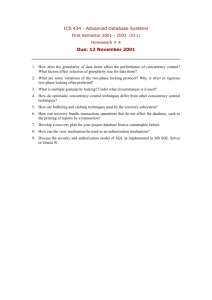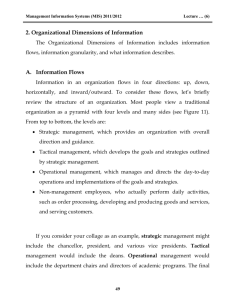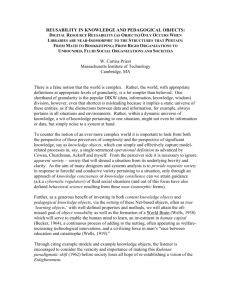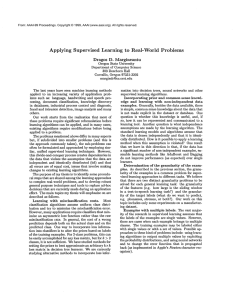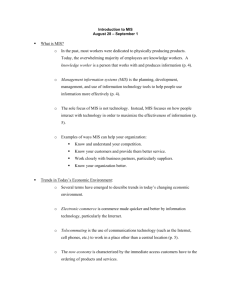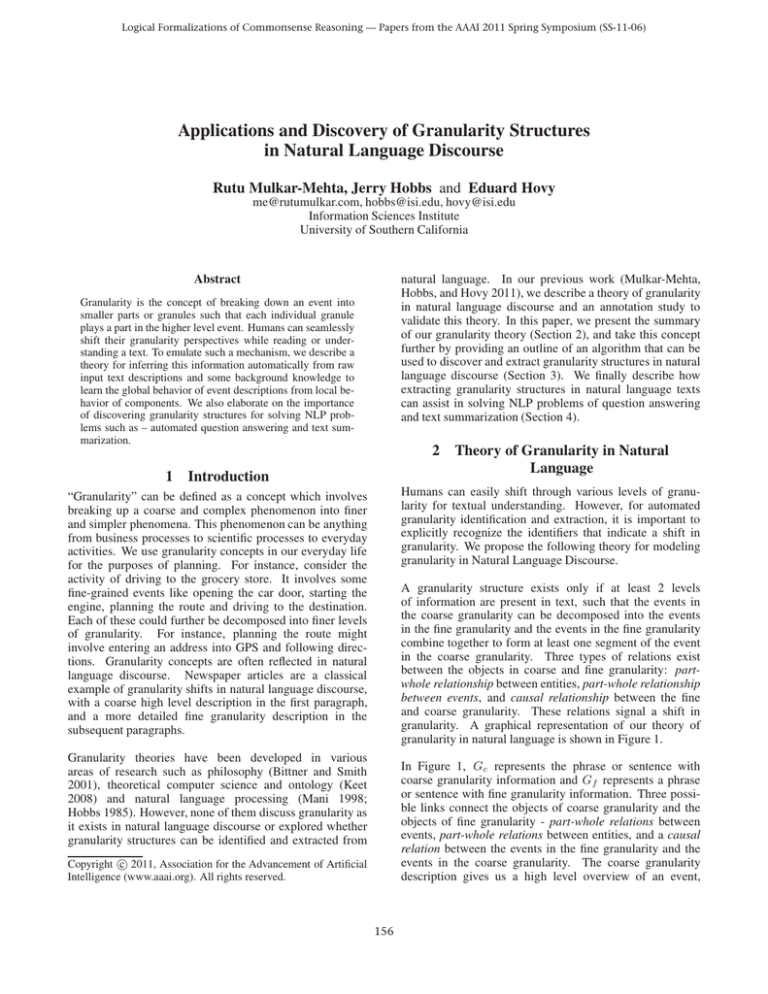
Logical Formalizations of Commonsense Reasoning — Papers from the AAAI 2011 Spring Symposium (SS-11-06)
Applications and Discovery of Granularity Structures
in Natural Language Discourse
Rutu Mulkar-Mehta, Jerry Hobbs and Eduard Hovy
me@rutumulkar.com, hobbs@isi.edu, hovy@isi.edu
Information Sciences Institute
University of Southern California
natural language. In our previous work (Mulkar-Mehta,
Hobbs, and Hovy 2011), we describe a theory of granularity
in natural language discourse and an annotation study to
validate this theory. In this paper, we present the summary
of our granularity theory (Section 2), and take this concept
further by providing an outline of an algorithm that can be
used to discover and extract granularity structures in natural
language discourse (Section 3). We finally describe how
extracting granularity structures in natural language texts
can assist in solving NLP problems of question answering
and text summarization (Section 4).
Abstract
Granularity is the concept of breaking down an event into
smaller parts or granules such that each individual granule
plays a part in the higher level event. Humans can seamlessly
shift their granularity perspectives while reading or understanding a text. To emulate such a mechanism, we describe a
theory for inferring this information automatically from raw
input text descriptions and some background knowledge to
learn the global behavior of event descriptions from local behavior of components. We also elaborate on the importance
of discovering granularity structures for solving NLP problems such as – automated question answering and text summarization.
2
1 Introduction
Theory of Granularity in Natural
Language
“Granularity” can be defined as a concept which involves
breaking up a coarse and complex phenomenon into finer
and simpler phenomena. This phenomenon can be anything
from business processes to scientific processes to everyday
activities. We use granularity concepts in our everyday life
for the purposes of planning. For instance, consider the
activity of driving to the grocery store. It involves some
fine-grained events like opening the car door, starting the
engine, planning the route and driving to the destination.
Each of these could further be decomposed into finer levels
of granularity. For instance, planning the route might
involve entering an address into GPS and following directions. Granularity concepts are often reflected in natural
language discourse. Newspaper articles are a classical
example of granularity shifts in natural language discourse,
with a coarse high level description in the first paragraph,
and a more detailed fine granularity description in the
subsequent paragraphs.
Humans can easily shift through various levels of granularity for textual understanding. However, for automated
granularity identification and extraction, it is important to
explicitly recognize the identifiers that indicate a shift in
granularity. We propose the following theory for modeling
granularity in Natural Language Discourse.
Granularity theories have been developed in various
areas of research such as philosophy (Bittner and Smith
2001), theoretical computer science and ontology (Keet
2008) and natural language processing (Mani 1998;
Hobbs 1985). However, none of them discuss granularity as
it exists in natural language discourse or explored whether
granularity structures can be identified and extracted from
In Figure 1, Gc represents the phrase or sentence with
coarse granularity information and Gf represents a phrase
or sentence with fine granularity information. Three possible links connect the objects of coarse granularity and the
objects of fine granularity - part-whole relations between
events, part-whole relations between entities, and a causal
relation between the events in the fine granularity and the
events in the coarse granularity. The coarse granularity
description gives us a high level overview of an event,
A granularity structure exists only if at least 2 levels
of information are present in text, such that the events in
the coarse granularity can be decomposed into the events
in the fine granularity and the events in the fine granularity
combine together to form at least one segment of the event
in the coarse granularity. Three types of relations exist
between the objects in coarse and fine granularity: partwhole relationship between entities, part-whole relationship
between events, and causal relationship between the fine
and coarse granularity. These relations signal a shift in
granularity. A graphical representation of our theory of
granularity in natural language is shown in Figure 1.
c 2011, Association for the Advancement of Artificial
Copyright Intelligence (www.aaai.org). All rights reserved.
156
Figure 1: Granularity in Natural Language Descriptions
abstracting away the details and looking at the big picture.
The fine granularity description provides the details of how
the event happened, abstracting away the big picture of the
overall effect of the fine grained events. At least one of these
relations must be present to infer a granularity structure in
the text, in which case the other relations may be inferred
(represented by the dotted lines in Figure 1). Instantiating
text phrases into this model produces granularities of text.
Consider the following simplified paragraph extracted from
a newspaper article describing a football game:
the granular causality extraction pipeline: Identification of
smallest discourse segment for analysis (Section 3.1); Creating a background knowledge base of Part-Whole relations
(Section 3.2); Inferencing Causal Granularity (Section 3.3);
Evaluation of the final results (Section 3.4). Algorithm 1
summarizes these sections and is the proposed algorithm for
extraction of granularity structures from text.
Algorithm 1 Algorithm for Automatic Discovery of Causal
Granularity Structures
1: Obtain part of relations (P ev1 ,W ev1 ...P evn ,W evn )
and (P en1 ,W en1 ...P enn ,W enn )
2: for all Article An do
3:
Obtain sentences ( S1 ...Sm ) in An
4: end for
5: for all Si ,Sj in Aa do
6:
for all (P evk ,W evk ), k = 1 to n do
7:
if P evk ∈ Si and W evk ∈ Sj then
8:
for all (P enq ,W enq ), q = 1 to m do
9:
if P enq ∈ Si and W enq ∈ Sj then
10:
Inference: Si causes Sj
11:
end if
12:
end for
13:
end if
14:
end for
15: end for
16: Evaluate the Causal Granularity Relations using Annotations
San Francisco 49ers lost 27-17 to the Green Bay Packers.
Brett Favre threw a three-yard touchdown pass to Keith
Jackson in the first quarter moving the 49ers ahead 7-0.
Brett Favre threw a 13-yard touchdown toss to Mark
Chmura in the second quarter moving the 49ers ahead 14-0.
Figure 2 shows the instantiation of the paragraph into
three levels of granularity, with the top level representing
the coarsest granularity, and the bottom level representing
the finest granularity. The part-whole links between entities
(Brett Favre is part of San Francisco 49ers) and events
(touchdown is part of a quarter, quarter is part of a game)
are marked. Causality is indicated by the word move,
linking two levels of granularity. The presence of causal
and part-whole relations indicates a shift in granularity
in the sentence, and the individual events in the sentence
can be split into two levels of granularity. The dotted line
represents an inferred causal relationship because of the
absence of explicit causal markers.
The evaluation of our causal granularity theory is provided in a separate compilation (Mulkar-Mehta, Hobbs, and
Hovy 2011), where we statistically prove this feature set
using a human annotation study for granularity identification. We achieve an average pairwise kappa (Cohen 1960)
agreement score of 0.85.
3.1 Identification of Smallest Discourse Segment
for Analysis
In order to identify shifts in granularity in discourse, we first
need to identify the discourse unit which can represent a single level of granularity. A granularity level can often span
multiple sentences, as shown in our previous work (MulkarMehta, Hobbs, and Hovy 2011), but for simplification purposes, we will consider a single sentence as a smallest discourse segment for analysis. In a given article (Aa ), the discourse segments of analysis are Si ...Sn , where the article
has n sentences.
3 Proposed Pipeline for Automatic Discovery
of Causal Granularity Structures
This section describes the basic building blocks and proposed algorithm for automatic discovery of causal granularity structures from discourse. There are four components in
157
Figure 2: Example of Granularity in Natural Language Text
3.2
Automatic Part-Whole relation extraction
3.4 Evaluation
Evaluation measures of the inferred relations will be obtained by passing the inferred relations to Mechanical Turk
and using crowd sourcing to judge the precision of the inferred relations in the sentence pair. A gold standard will be
developed using the Mechanical Turk annotations.
There are 2 types of meronymic part-of relations required
for causal granularity extraction - entity part-whole relations (P en,W en) and event based part-whole relations
(P ev,W ev).
(Winston, Chaffin, and Herrmann 1987) discuss meronymic
relations and a taxonomy for representing them. They
introduce six types of part-whole relationships: (i)
Component-Integral (e.g., pedal is a component of the
integral bike), (ii) Member-Collection (e.g., a ship is a
member of the collection, a fleet), (ii) Portion-Mass (e.g.,
a slice is a portion of the mass, a pie), (iv) Stuff-Object
(e.g., steel is one of the ingredients/stuff of the object car),
(v) Feature-Activity (e.g., paying is one of the features
of the whole activity of shopping), (vi) Place-Area (e.g.,
Everglades is a place within the area of Florida). For
discovery of granularity relations, the Feature-Activity
type relation is the event based part-whole relation and the
remaining categories are part-whole relations for entities.
4 Applications of Granularity Structures for
solving NLP problems
Having described the theory of granularity in text, and the
algorithm for extracting such relations, we now describe different areas of NLP which will benefit from granularity relations. This section focuses is on 2 areas – Automated Question Answering and Text Summarization.
4.1 Automated Question Answering
Question answering has achieved high degrees of precision
and recall for fact based questions such as - what, when,
where (Hovy et al. 2001). However, this field has few
contributions for answering causality based questions.
“How” and “why” are two ways of asking causal questions
in English. Both of these question types remain the most
difficult types of questions to answer by automated question
answering techniques. New methods and models have been
introduced such as (Mrozinski, Whittaker, and Furui 2008;
Verberne 2009) for answering these style of questions.
However, it has been largely overlooked that cause and
effect relations might not always be sequential, but might
happen at the same time, where an event happening to a part
entity causes an event to a whole entity. For example, a car
stops working when the engine breaks down, a team wins a
game when an individual scores, a building collapses when
the roof caves in, and so on. In these cases, there might
not be a sequential causality present between these events,
but a granular causality. A very effective way to extract
such relations is using granularity structures. This can be
achieved in the following manner.
Several initiatives such as (Girju, Badulescu, and Moldovan
2003), (Hage, Kolb, and Schreiber 2006) and (Ittoo et
al. 2010) have attempted to extract general part-whole
relations from discourse. As a first step, we will re implement these state of the art techniques for part-whole
relation extraction to obtain part of relations for events
(P ev1 ,W ev1 ...P evn ,W evn ) and part of relations for
entities (P en1 ,W en1 ...P enn ,W enn ).
3.3
Inferencing Causal Granularity
In this step we consider two sentences in the corpus S1
and S2 and check whether there exists (P ev,W ev) and
(P en,W en) pairs in the sentence pair, where P ev and P en
lie in S1 and W ev and W en lie in S2 . We can then derive
the inference that S1 causes S2 , where S1 contains the event
and entity parts and S2 contains the event and entity wholes.
The theory of granularity is shown in Figure 1, repre-
158
senting two levels of granularity and three types of relations
between them: part-whole relations between events, partwhole relations between entities and causal connectives.
For instance, consider Figure 2 that instantiates the theory
of granularity to the paragraph mentioned in Section 2.
As a part of the future work we have already started
working on developing a system for automatic granularity
extraction. We will compare this with the state of the
art techniques for answering causality style questions
to empirically evaluate the significance of granularity
structures for question answering. Results of our system
for automatic extraction of granularity can be found in a
separate compilation (Mulkar-Mehta et al. in review).
Asking a question about the coarse granularity from
Figure 2, one could ask the question: How did the San
Francisco 49ers win the game?, to which the answer can
be provided by going down one level of granularity and
answering: because they went ahead 7-0 in the first quarter
and 14-0 in the second quarter. Another possible question
is: How did the San Francisco 49ers move ahead in the
first quarter?, to which the reply would be from a finer
granularity level : Brett Favre threw a three-yard touchdown
pass.
References
Bittner, T., and Smith, B. 2001. Granular partitions and
vagueness. Proceedings of the international conference on
Formal Ontology in Information Systems - FOIS ’01.
Cohen, J. 1960. A coefficientof agreement for nominal
scales. Educational and Psychological Measurement 20.
Girju, R.; Badulescu, A.; and Moldovan, D. 2003. Learning semantic constraints for the automatic discovery of partwhole relations. Proceedings of the 2003 Conference of the
North American Chapter of the Association for Computational Linguistics on Human Language Technology - NAACL
’03 1:1–8.
Hage, W. R. V.; Kolb, H.; and Schreiber, G. 2006. A
Method for Learning Part-Whole Relations. Proceedings
of the 5th International Semantic Web Conference (ISWC
2006) 4273:723 – 736.
Hobbs, J. R. 1985. Granularity. In Proceedings of the
Ninth International Joint Conference on Artificial Intelligence 432–435.
Hovy, E.; Gerber, L.; Hermjakob, U.; Lin, C.-Y.; and
Ravichandran, D. 2001. Toward semantics-based answer
pinpointing. Proceedings of the first international conference on Human language technology research - HLT ’01.
Ittoo, A.; Bouma, G.; Maruster, L.; and Wortmann, H. 2010.
Extracting Meronymy Relationships from Domain- Specific
, Textual Corporate Databases. NLDB 48–59.
Keet, C. M. 2008. A Formal Theory of Granularity. Ph.D.
Dissertation, Faculty of Computer Science, Free University
of Bozen-Balzano, Italy, Oxford, UK.
Mani, I. 1998. A Theory of Granularity and its Application
to Problems of Polysemy and Underspecification of Meaning. In Principles of Knowledge Representation and Reasoning: Proceedings of the Sixth International Conference
(KR’98) 245–255.
Mrozinski, J.; Whittaker, E.; and Furui, S. 2008. Collecting a Why-question corpus for development and evaluation
of an automatic QA-system. Association of Computational
Linguistics (June):443–451.
Mulkar-Mehta, R.; Hobbs, J. R.; and Hovy, E. 2011. Granularity in Natural Language Discourse. International Conference on Computational Semantics 360—-364.
Verberne, S. 2009. In Search of the Why. Ph.D. Dissertation,
University of Nijmegen, Oxford, UK.
Winston, M. E.; Chaffin, R.; and Herrmann, D. 1987.
A Taxonomy of Part-Whole Relations. Cognitive Science
11(4):417–444.
The first step to achieving such a QA system is to
identify different granularities of information from a given
text and instantiating the granularity model with the texts.
We already have an evaluation study of this work, and will
present the results as a separate compilation (Mulkar-Mehta
et al. in review).
4.2
Text Summarization
The granularity model represents a single time slice and all
the events happening within it belonging to different grain
sizes. If an entire text of information is represented into
this granularity model, getting a summary of the events
involves going up in the model to find the coarser grained
information. For example, consider a game of football,
where a lot of individual scoring events of touchdowns,
field goals or the kick after a touchdown are present. If one
asks for the summary of the first quarter, one can look at all
the events happened in the first quarter and present the final
results. Similarly, if one is interested in the final outcome
of the game, the system can abstract all the fine grained
information and prove just the top level information in the
coarsest granularity.
If such a multi-granular structure is obtained from text, a
text summary can be obtained by going up the granular
hierarchy, abstracting away the low level details from the
text. For instance, consider Figure 2. If the summary of the
first quarter is required, one can give the coarsest granularity
information describing the first quarter which is the 49ers
moved ahead 7-0. Similarly, if one wants the summary
of the game, we could go to the coarsest granularity level
describing the game and answer San Francisco 49ers won
the game 27-14.
5 Conclusion
In this paper we present the theory of granularity for natural
language texts and an algorithm for extraction of such
granularity structures from discourse. Finally we present
different applications of the theory of granularity for solving
NLP problems of automated question answering and text
summarization.
159

